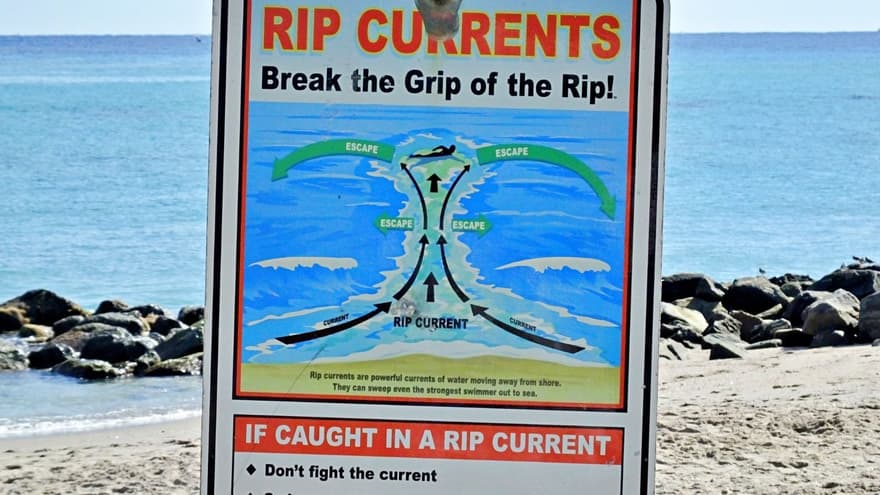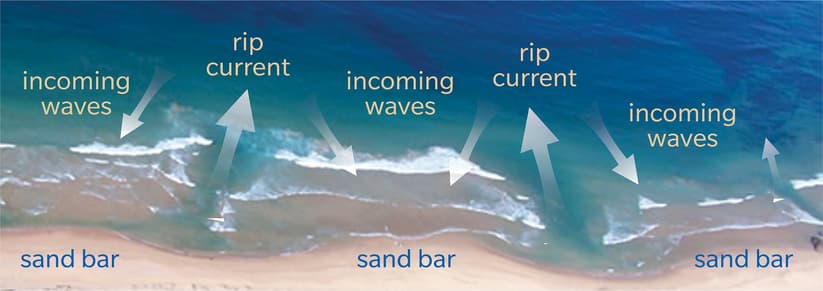3 August, 2022
With many of us heading to the coasts this summer, especially as the weather warms up, we share some safety advice about rip currents to help you make the most of your time out in the open water in our coastal areas this summer.

A rip current is one of the most dangerous hazards in the water. It is a strong, fast-moving water current that flows away from the shore and even the strongest swimmers in the world will likely not be able to swim against one when they're really ripping.
Rip currents are most often found at low spots or breaks in the sandbar and near structures such as piers, jetties, and reefs. They can also be found on any beach with breaking waves. Imagine that you're in a bay. All the water that is coming into that bay needs to escape somewhere right?
For example, if there's a small gap in the sandbar or some other feature that allows water to flow more easily away from the shore, that's where you'll likely find a rip current taking that water that's been pushed in by the surf, back out to sea.
If you watch surfers this summer, the good ones will use any rips available to them to help get out through the waves more easily and have to spend less time paddling and more time surfing!
Rip currents can be hard to spot from the shore, but there are a few tell-tale signs that can help you out.
First of all, look for any flat areas of water in the ocean. Rips tend to form in these areas as they're usually low spots in the seafloor / beach.
Secondly, look for any areas where the water is a different color than the surrounding water.
Rips will often create a line of discoloured, murky water that can be easy to spot from the shore.
Finally, look for any areas where there seems to be foam or debris floating out to sea. This is another good indicator that there may be a rip current in the area.
Rip Current Image by SLS Beachsafe

Most major beaches will have lifeguards and the lifeguards are trained to look for things like rips. It's why you will likely see them moving the flags regularly or talking over their tannoy advising bathers where to go.
If you're ever unsure, the best thing to do is always swim at a lifeguarded beach and speak to the lifeguards on duty about any rip currents that may be present.
It is highly unlikely you will be able to swim against a rip current and if you're in the sea, you may not know you're in one until you start getting pulled out to sea. STAY CALM.
The best thing to do, if you find yourself caught in one is to stay calm and swim parallel to the shore (swimming across the beach for example) until you are out of the current and then you will likely be more easily able to swim back into the beach. Depending on your ability and the location and width of the rip, you could also let the rip take you out until it weakens and you can swim back to shore.
If you can't swim out of the rip or you're too tired to try, then float on your back and raise your hand or tread water if you can. Lifeguards will hopefully spot you and come to your aid.
If you see someone else caught in a rip, don't go in to try and save them. Call the lifeguards or if they're close enough, tell them to swim parallel to the shore immediately.
Remember - safety first!
Stay calm
Swim parallel to the shore
Float to live or treadwater and shout and signal for help
For more information see - https://rnli.org/safety/know-the-risks/rip-currents
If you see someone in trouble then call 999 or 112 and ask for the coastguard

Outside & Active is the home for those who love the outdoors. Our mission is to inspire, inform and educate people about being active outdoors in a fun, safe and sustainable way. We provide inspiration, kit, tech and advice on adventure, camping, climbing, cycling, hiking, running water and winter.
Most recent articles by Outside & Active

Brooks supports trail runners to defy limits and empower their trail runs with the new Cascadia 18. The adaptable Cascadia combines DNA Loft v2 cushioning with TrailTack Green grip and a durable upper mesh to handle all terrains, providing necessary comfort and underfoot security on each surface.

Connectivity makes eBiking more customised, convenient and secure.

Various app solutions, interfaces and services as the next step for the eBike experience of tomorrow
Most recent articles in WATER
Wild swimming is a popular pastime but it can be tricky to know where to start gaining the knowledge and confidence to begin.

Did you miss out on attending this year's National Outdoor Expo? Or simply feeling the blues from the show and want even more EXCLUSIVE content? The National Outdoor PodShow is the one-stop-shop for those who love the outdoors.

National Outdoor PodShow sponsors YONDA are giving you the opportunity to win the ultimate swimmers bundle. Enter now!